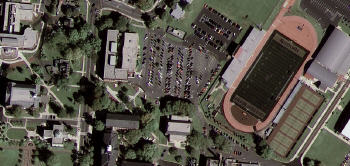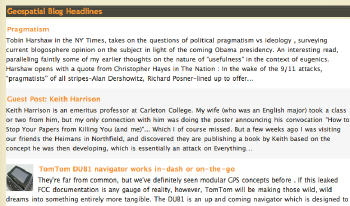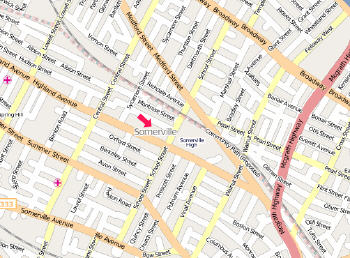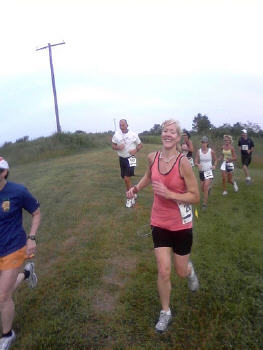I sat down to write my annual list of "10 events,
ideas, themes, products, etc. that stood out over the preceding 12
months" but found it more difficult than usual. There were some things
I "could" talk about (John King and the Magic Wall, the iPhone,
geotagging as mainstream, warehouse appliances and XML databases), but
they really weren't standouts. There were some "continuations" of
existing trends (open source, cloud computing, Web 2.x/3.x) but again,
nothing that shook the foundations of our industry. In the end, I
deemed the list "lame." My editor-in-chief, Joe Francica, agreed with
my description and noted a few things that I might have added (spatial
regression, SQL Server 2008 with geo support, GeoEye-1), but even those
felt like "more of the same." Don't get me wrong, I see progress, but
nothing like the things I'd identified and felt strongly about in past
years.
 |
GeoEye-1
imagery, like this "first image" of Kutztown
University, will provide .5 meter resolution to the world via Google's
mapping properties. (Image courtesy GeoEye)
(Click for larger
image)
So, what's going on? Is it me? Am I, and I hate to ask this question
because it makes me feel old, getting jaded? Have I reached a "there's
nothing new under the sun" view of geospatial technology? I don't think
so. Some things excited me quite a bit this year, including
ESRI's
vision of data finding via Google tools and the introduction of
FortiusOne's
Maker!. I'm guilty of not following up much on these.
Still, they are both having an impact of sorts. Regarding data
"findability," I was jazzed to see
GeoServer's
new tools for making
geodata findable via a Google search, which launched this past week. As
for Maker!, I'm happy to report that the reporter from the Boston Globe
who called about a "Year in Maps" article, found the
Dataset
of the Day
series on the Off the Map Blog terrific.
Am I looking in the right places? Certainly my "sources" for news about
geospatial have exploded in the past year or so with more e-mails,
press releases, blogs, tweets, podcasts, videos and, thankfully, fewer
phone calls. Is it possible that the variety of communications channels
has spread the "news" so thin that none of it achieves "critical mass"
such that it makes an impression on me? I would not discount that
explanation, but it's certainly not the whole story.
 |
One of
my sources, the GeoSpatial News Aggregator.
(Click for larger
image)
Or is it, as Joe Francica noted in a recent
editorial,
that we've
crossed a chasm and are now in a mode of "diversity, segmentation and
focus"? And if so, what do those three terms mean for finding "10
events, ideas, themes, products, etc. that have stood out over the
preceding 12 months" that speak to our entire community? In pondering
this situation further, I think the diversity of uses and users, from
those who mash-up to those creating new spatial algorithms for vector
and raster data, reinforces that we are less likely now, perhaps than
ever, to point to the same "big events, launches, trends." The
segmentation Francica points to does the same thing. The implementation
of an enterprise GIS may well include a geospatial appliance, but only
the system administrator may know about it. The analyst at her desk may
be querying data faster but analyzing data in ArcGIS as she always did.
Thus, the selection and implementation of a solution from a Netezza or
Teradata may not be on her radar. Similarly, those geospatial
practitioners who manage the datastore in those databases may not
really notice that data being fed in aren't from a commercial vendor,
but from OpenStreetMap. To him, there's no difference; it's just
"data." Francica's ideas regarding focus are applicable here, too. At
one time it seemed ESRI, Autodesk, Intergraph and MapInfo (and others)
were in the same business, GIS. Today, they most assuredly are not.
They deal in (these are my terms, not the vendors) broad geospatial
technology, infrastructure, security/military/intelligence and
business-focused location intelligence, respectively.
 |
OpenStreetMap
data rocks some GIS users' worlds, but not
others'.
(Click for larger
image)
What does all this say about the state of geospatial technology? I
think Francica has it exactly right - it's mature. I know that I miss
that users can't all sit in a room together and get "wowed" by the same
new technology, as perhaps we did even five, let alone 10 or 15 years
ago. On the other hand, we can still appreciate that advances in
other corners, while not directly touching us now, may in time, or via
new connections between our data, applications and hardware.
 |
Each
runner has different preferences, but all share a love of
running. (Photo (c) Larry Sandhaas, used with permission.)
(Click for larger
image)
The analogy I'm holding in my head as I write this involves my running
club. We are some 400 strong. Some like to race short distances (less
than a mile), others longer (six to ten miles), others even longer (26
to 50 to 100 miles). Some don't race at all. Some like to run in the
woods; some wouldn't ever try that. Some like to run alone, others in
large unwieldy packs. What holds us together? We all like to run.
Within geospatial, we may be pulled to a particular disciplinary use of
the technology (forestry, health care, agriculture), or part of the
technology stack (database, middleware, application), or hardware
solution (desktop, field unit, mobile phone), but we are all pulled to
this technology by love or money. So, perhaps it doesn't matter that we
don't now, and may not for some time, identify the same year-end
inventory list of great steps forward.



